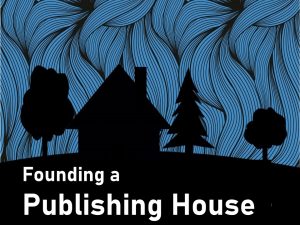 In order to compete with traditionally published books, many self-publishers choose to found their own publishing houses. Not only does this lend an air of professionalism to their writing endeavors, it serves to separate book publishing activities from personal income, providing a necessary level of legal and financial protection to self-publishers.
In order to compete with traditionally published books, many self-publishers choose to found their own publishing houses. Not only does this lend an air of professionalism to their writing endeavors, it serves to separate book publishing activities from personal income, providing a necessary level of legal and financial protection to self-publishers.
America’s Small Business Development Center (SBDC) represents a nationwide network of the most comprehensive small business assistance in the United States. Hosted by colleges, universities, state economic development agencies, and private partners, there are nearly 1,000 local centers nationwide. Aspiring indie publishers (and other entrepreneurs) can connect with their local SBDCs for no-cost and low-cost business consulting. While it is entirely possible to establish a publishing house on their own, indie publishers may feel more confident knowing that they have the support of their local SBDC to help guide them through the process.
10 Steps to Founding a Publishing House
Step 1: Choose a Name
This is the first, and arguably, the most important step. Not to mention the most frustrating. The name needs to be professional, fit the publisher’s brand, and not already in use. It’s important to remember that if a name has already been trademarked it cannot be used. For example, someone wishing to publish pulp fiction under the name “Pulp & Paper” may be disappointed to find the name is currently used by a paper mill.
To discover if a business name is available, search the Secretary of State’s database for your state. (In Idaho visit www.sos.idaho.gov) If the name is not already in use in your state, contact the US Trademark Office and search their database. It may take several days and some creative thinking, but having a uniquely identifiable name is worth the effort.
Step 2: Register with the Secretary of State
When registering with the Secretary of State (SOS) new business owners are required to choose a business structure. There are three principal structure to choose from:
- Sole Proprietorship
- Limited Liability Corporation
- S-corporation
The cheapest and easiest option is to become a sole proprietorship. In Idaho, for a $25 fee an indie publisher can register an “Assumed Business Name” (ABN), which allows them to report business income on their personal income taxes. However, this leaves them vulnerable to any legal and financial difficulties that might arise later.
The next simplest option is to become a limited liability company (LLC). By paying the $100 fee to incorporate, an Idaho business owner’s personal income and assets are shielded from lawsuits. Taxed similarly to a sole proprietorship, an LLC keeps business income and personal income separate and requires separate bookkeeping.
An S-corporation also shields personal income and assets from lawsuits and provides greater tax advantages, but comes with an extra layer of paperwork. It is advisable to contact a certified public accountant (CPA) to determine if this option is a good fit for your company.
Step 3: Hire an Accountant
Everything will run smoother if you have a budget in place before moving forward. If you haven’t already contacted a CPA, do it now. Familiarize yourself with the IRS Schedule C, know what’s tax deductible, what counts a business expense and what doesn’t, and what items can be depreciated.
Not sure what to put in your budget? Check out this post, Budgeting for Publication
Step 4: Apply for an EIN
An Employer Identification Number (EIN) can be obtained from the IRS for free. An EIN is required to open a business checking account. This is a necessary step to ensure that business and personal expenses are not comingled.
Step 5: Open a Bank Account
Every bank has different requirements for setting up business accounts and the process will vary from bank to bank. Take time to find a bank that works best for you and your business. With a business bank account in place, it’s time to implement a system for tracking expenses. Never buy personal items with a business account and vice versa as this will cause a headache at tax time.
Those planning to monetize their websites and fulfill orders themselves will need PayPal, Stripe, and WooCommerce accounts for online transitions. All of these should be linked directly to the business checking account.
Step 6: Trademark Registration
Trademark registration ranges in price from $250 to $350. All graphics and images need to be filed with the initial application. That means logo creation needs to occur before completing the trademark registration process. Since the publishing house’s logo will grace everything from the headers on stationary, to website banners, and the spine of every book they publish, it’s important to love your logo. It’s possible to hire a graphic designer to create a logo for under $500 and those who qualify may be able to obtain logo creation through SBDC special programs at no cost. Finally, depending on the complexity of the application, it may be advisable to hire an attorney that specializes in business creation to file the trademark on your behalf.
Step 7: Purchase a Domain Name
Purchasing a domain name and creating a website adds a layer of professionalism to the company. It will also be a place to post lists of the publisher’s books and other information pertinent to the business.
Domain names can be purchased from GoDaddy. Keep several domain names in mind because many are already be taken and prices can vary greatly. For example, hartandhind.com cost $1500, whereas hartandhindpc.com only cost $15. Remember to renew domain registration annually, otherwise it might get purchased by someone else and the new owner may charge a ridiculous amount in order for you to get it back.
See more information on website building with this post: Building an Author Website
Step 8: Buy ISBNs and Register with Bowker
The purpose of an International Standard Book Number (ISBN) is too uniquely identity the book, publisher, and edition, allowing for more efficient marketing by booksellers, libraries, universities, wholesalers, and distributors. Bowker is the company responsible for ISBNs in the United States. It only takes 5 business days for non-priority processing of an ISBN.
Each format, binding, or edition of a book must have a separate ISBN (i.e. hardcover, paperbound, e-book, audio book, etc.) So, it’s wise to purchases a block of ISBNs. Like much else in life, ISBNs are cheaper when bought in bulk: a block of 10 cost $295, 100 cost $575, and 1000 cost $1500.
BEWARE of offers from unauthorized re-sellers peddling ISBNs at discounted prices. Publishers with re-assigned ISBNs will not be correctly identified as the publisher of record in Books In Print or any of the industry databases.
See more information on ISBNs in this post: ISBNs, Copyrights, and Barcodes, Oh my!
Step 9: Choose a Distribution System.
There are five distribution systems to consider:
- Self-distribution
- Consignment
- Print-on-Demand Services
- Wholesalers
- Distributors
Self-distribution. Direct-to-consumer fulfillment allows indie publishers to sell books directly to consumers through their website. This is seen as a way to maximize royalties by cutting out the distribution chain and its associated fees. However, few people are going to stumble across the website of an unknown publishing house and want to buy their books.
Consignment. Consignment is a well-established arrangement in the book trade and helps small presses reach new readers. Those who have a good relationship with their local bookseller may wish to consider a consignment agreement since indie bookstores are more willing to stock titles from small publishers than chain stores.
Print on Demand. Many print-on-demand (POD) services, like Amazon and Lulu, sell books on their platforms, increasing the indie publisher’s reach while still enabling them to purchase copies for their own self-distribution.
Wholesalers. Using wholesalers as the middleman between the publisher and the bookstore is beneficial for both parties. Bookstores can place a single order for multiple titles from variety of publishers and return unsold copies in a single transaction. On the flip side, small publishers who often have difficulty getting paid for books sold on consignment no longer need to handle sales and collections. The wholesalers handle sales and shipping, then distributes royalties to the publisher monthly or quarterly.
Distributors. Full-service distributors provide indie publishers with fulfillment, marketing, warehousing, contract management, and enables indie publishers to operate competitively with major houses. The principle advantage to using a distributor is having a dedicated sales force who actively pitches books directly to wholesalers, bookstores, libraries, and other retail outlets. As compensation, distributors take a percentage of the net sales and distribution fees can vary widely.
See more information on book distribution in this post: Book Distribution: What are your options?
Step 10: Register for a Sales Tax ID Number
Depending on which states your business operates in, you may be required to collect sales tax. Even those who will not be publishing for several years, and have no sales, may still need to file quarterly forms with columns filled with zeros. Fortunately, in Idaho, acquiring a Sales Tax ID number can be delayed until just before the first book is published, eliminating the need to file quarterly reports before any sales take place.
(In Idaho register at: www.labor.idaho.gov/ibrs/ibr.aspx)
Congratulations! If you made it through all ten steps, you have formed your own independent publishing company. Fire the cupcake cannons and throw a party to celebrate your success!
